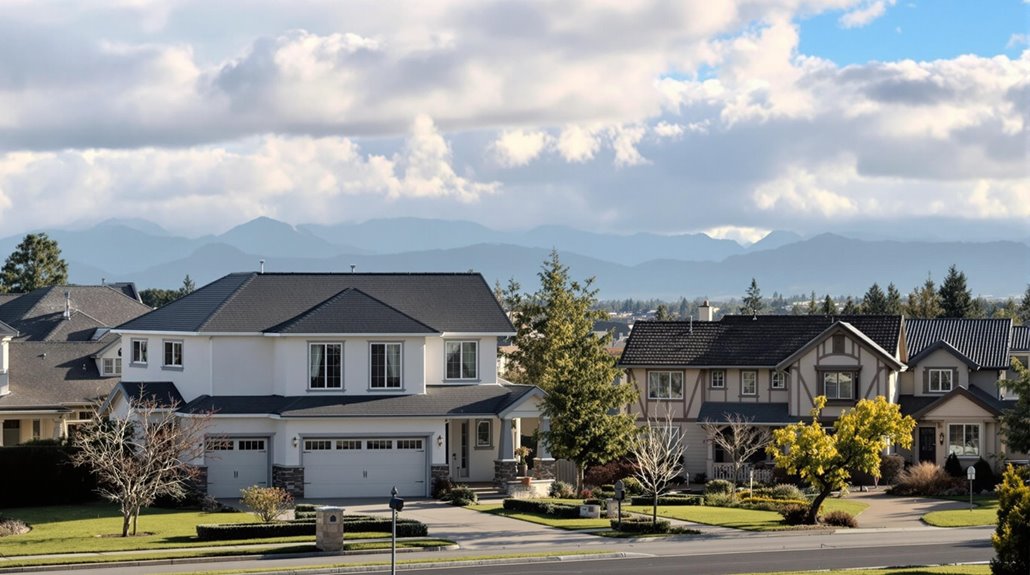Think of your homeowners insurance premium as your safety subscription – you know, like Netflix, but for protecting your castle! 🏠
Ever wondered what makes up that number on your insurance bill? Your premium is the regular payment you make to keep your home's safety net strong and ready. It's fascinating how insurance companies cook up this number, considering everything from your neighborhood's storm history to whether you've got a fancy security system.
Would you believe that Americans typically shell out $2,230 yearly for $300,000 in dwelling coverage? But don't let that number scare you – your premium might be totally different. It's like a fingerprint, unique to your situation.
What drives your premium up or down? Let's break it down:
- Your home's location (beachfront property? prepare for higher rates!)
- Building materials and age (newer homes often cost less to insure)
- Your claims history (think of it as your insurance report card)
- Security features (alarms and cameras can be money-savers)
- Coverage choices (more protection = higher premium)
Smart homeowners know that understanding these premium factors is like having a GPS for insurance savings. You can navigate your way to better rates by making informed choices about your coverage and home improvements. Remember, your premium isn't set in stone – it's more like clay you can shape with the right moves!
Key Takeaways
- A homeowners insurance premium is the amount paid for a policy, averaging $2,230 annually in the U.S. for $300,000 in dwelling coverage.
- Premium costs are influenced by factors such as location, home characteristics, coverage limits, deductible, and personal factors like credit score.
- Higher deductibles typically result in lower premium costs, with potential reductions of 10% to 20% or up to 18% annually.
- Regular policy reviews ensure adequate coverage and potential savings, while regular property maintenance can reduce premiums by 10-15%.
- Timely payment of premiums is essential to avoid policy cancellation or penalties, with various payment options available for homeowners.
Understanding Homeowners Insurance Premiums
The concept of homeowners insurance premiums is multifaceted, influenced by a range of factors that ultimately determine the cost of coverage. A homeowners insurance premium is the amount paid for a policy, varying based on factors such as location, home characteristics, and selected coverage limits.
The average annual cost in the U.S. is approximately $2,230 for $300,000 in dwelling coverage. Several factors are used to determine homeowners insurance premiums, including risk of natural disasters, age and construction materials of the home, and claims history and credit score of the homeowner.
Adjusting the deductible can affect premium costs, as a higher deductible can lower the premium. Understanding the relationship between coverage limits, deductibles, and premiums is vital for homeowners to make informed decisions.
Regular review of insurance policies is necessary to guarantee adequate coverage and potential savings. Coverage limits also play a significant role in determining homeowners insurance premiums. Homeowners can save up to 25% on their premiums through policy bundling with other insurance products.
Determinants of Home Insurance Premium Costs

Because multiple factors contribute to the overall cost of homeowners insurance premiums, understanding these determinants is vital for homeowners seeking to manage their expenses effectively.
A primary factor is the location of the home, with areas prone to natural disasters resulting in higher premiums. The characteristics of the home itself, such as age, size, and construction materials, also considerably impact premium rates.
A homeowner's insurance score, which is derived from credit report components, plays a key role in determining premiums, with higher scores generally leading to lower rates.
The selected coverage options and limits directly impact premium costs, as do deductible amounts. Higher deductibles typically result in lower premium costs, while lower deductibles lead to increased premiums.
Understanding the interplay between these factors is essential for homeowners to make informed decisions about their coverage and manage their homeowners insurance premium costs effectively. This enables them to balance coverage needs with premium costs.
Homeowners can save 15 to 25 percent on their premiums by bundling their home insurance with other policies like auto insurance.
Home Insurance Premiums and Payment Options

Homeowners insurance premiums necessitate regular payments to maintain coverage, with payment frequencies typically set at monthly or annual intervals. The average homeowners insurance premium is around $2,230 annually for $300,000 in dwelling coverage in the U.S. as of July 2024. To avoid policy cancellation or penalties, timely payment is essential.
Payment options for homeowners insurance premiums include:
- Escrow payments: Combining insurance and property tax payments into monthly mortgage installments.
- Direct payments: Paying the insurer directly using credit cards, checks, or electronic funds transfers.
- Annual payments: Paying the full premium annually, which may offer discounts.
- Flexible payment plans: Some insurers allow homeowners to adjust their payment schedules based on their financial situation.
Homeowners should consider their financial situation and the coverage they need when selecting a payment option, as late payments can lead to higher premiums or insurance claims being denied. Choosing a higher deductible amount can reduce annual premium costs by up to 18% for most homeowners.
Factors That Affect Homeowners Insurance Premiums

As location plays a pivotal role in determining homeowners insurance premiums, areas with high exposure to natural disasters, such as coastal regions prone to hurricanes or flood-prone zones, tend to incur higher rates. This increased risk leads to elevated rebuilding costs, which insurance providers account for in their premium calculations.
In addition to location, a homeowner's claims history is a significant factor, as frequent claims often result in increased premiums. Conversely, a good claims record may contribute to lower home insurance premiums.
Personal factors, such as credit score, also affect premium rates, with higher scores generally leading to lower rates. Coverage options and deductibles selected within the homeowners insurance policy also impact the premium, with higher coverage limits and lower deductibles resulting in increased costs.
These various factors interact to determine the overall premium rate in a homeowners insurance policy. Credit score also impacts the coverage options. Regular property maintenance costs can help reduce insurance premiums by 10-15% through decreased risk assessment.
Managing and Customizing Homeowners Insurance Premiums

Tailoring a homeowners insurance policy to fit specific financial needs and risk tolerance involves customizing the premium through various coverage and deductible options. The premium is based on multiple factors, and understanding the relationship between coverage limits and deductibles is essential in managing and customizing homeowners insurance premiums.
To make informed decisions when customizing a policy:
- Coverage assessment: Obtain multiple homeowners insurance quotes and compare coverage limits and insurance rates.
- Deductible options: Weigh the benefits and drawbacks of raising deductibles to lower premiums, which involves agreeing to pay more out-of-pocket in the event of a claim.
- Optional coverages: Consider adding supplemental coverages, such as flood or earthquake insurance, which may have a significant impact on policy terms.
- Policy reviews: Regularly review and compare policies to identify potential savings or better coverage options, and take advantage of discounts for implementing safety features.
Most standard policies include personal property coverage at approximately 50% of the total dwelling coverage amount.
Strategies for Lowering Homeowners Insurance Premiums

Customizing a homeowners insurance policy to fit specific financial needs and risk tolerance is only the first step in optimizing premium costs.
To lower premiums, homeowners can leverage various strategies. Maintaining a good claims history is vital, as insurers reward policyholders with lower rates for not filing frequent claims.
Increasing the deductible amount can also greatly reduce premium costs; for instance, raising the deductible from $500 to $1,000 may lower premiums by 10% to 20%.
Additionally, installing security features such as burglar alarms and smoke detectors can qualify homeowners for discounts, potentially reducing premiums by up to 15%.
Bundling homeowners insurance with auto insurance or other policies can lead to combined discounts, with savings ranging from 5% to 25%.
By taking advantage of available discounts and adjusting coverage options, homeowners can effectively lower their premiums and optimize their homeowners insurance policies.
This can result in considerable cost savings over time.
The Benefits Of Consulting A Public Adjuster

In the context of homeowners insurance claims, consulting a public adjuster can provide policyholders with specialized expertise in maneuvering complex insurance claims processes.
Public adjusters offer an objective assessment of damage, which is essential in determining accurate claim amounts and ensuring that policyholders receive fair compensation.
Expertise In Insurance Claims
Numerous homeowners navigate the complex and often intimidating process of filing insurance claims without professional assistance, resulting in potential underpayment or delayed settlements.
A public adjuster can provide expertise in insurance claims, ensuring policyholders receive the maximum compensation for their losses.
Some key benefits of consulting a public adjuster include:
- In-depth policy knowledge: Public adjusters possess a thorough understanding of policy language and can effectively interpret coverage details.
- Streamlined claims process: They document damages, prepare necessary paperwork, and negotiate with the insurance company on behalf of the homeowner.
- Higher settlements: Studies show that policyholders who use public adjusters often receive considerably more than those who handle claims independently.
- Fiduciary duty: Public adjusters are hired by the homeowner and have a fiduciary duty to act in their best interest, unlike insurance adjusters who work for the insurance company.
Objective Damage Assessment
A critical component of the insurance claims process is an objective damage assessment, which can be obtained by consulting a public adjuster. This assessment guarantees that all losses are accurately evaluated and documented, providing a fair basis for claims.
Public adjusters, licensed professionals working on behalf of policyholders, advocate for fair compensation based on actual damage incurred, rather than relying solely on the insurer's assessment. By hiring a public adjuster, policyholders can receive settlements that are 20-30% higher than those who handle claims independently.
Public adjusters also identify hidden damages, such as mold or structural issues, impacting the overall claim value. Their detailed reports and estimates streamline the claims process, reducing time and stress involved in securing a fair settlement from the homeowners insurance company.
Streamlined Claim Process
When traversing the often-complex process of filing a homeowners insurance claim, consulting a public adjuster can greatly enhance the efficiency and fairness of the outcome.
By providing expert assistance in documenting and valuing damages, public adjusters guarantee that homeowners receive a fair settlement.
The benefits of consulting a public adjuster include:
- Streamlined claims process: Public adjusters handle all communication with the insurance company, saving homeowners time and stress.
- Expert policy analysis: Public adjusters navigate complex policy language and coverage options to guarantee all eligible damages are claimed.
- Accurate damage assessment: Public adjusters provide objective assessments of damages to maximize potential benefits.
- Efficient claim resolution: Public adjusters work to resolve claims quickly, allowing homeowners to focus on recovery and minimize premium increases.
Higher Claim Payouts & Settlements
Homeowners seeking to maximize their insurance claim benefits can achieve considerably higher payouts by leveraging the expertise of a public adjuster.
Consulting a public adjuster can lead to increased claim payouts due to their expertise in evaluating property damage and negotiating with insurance companies on behalf of the policyholder. Their knowledge of homeowners insurance policies enables them to identify overlooked coverage options, ensuring all eligible damages are claimed.
Studies have shown that policyholders who hire public adjusters receive settlements up to 747% higher than those who handle claims independently. Public adjusters' fees, typically 5% to 15% of the settlement amount, are often covered by the increased claim amount, benefiting the policyholder.
Their involvement can also expedite the claims process.
About The Public Claims Adjusters Network (PCAN)

Established as a trusted resource for policyholders, the Public Claims Adjusters Network (PCAN) comprises a national network of pre-vetted, verified, and state-licensed public adjusters specializing in residential and commercial property damage insurance claims.
This network connects policyholders with top-tier public adjusters who possess expertise in their field and adhere to high standards of ethics, morals, and professionalism.
To help you understand the benefits of working with PCAN, consider the following:
- Expertise: PCAN member adjusters cover over 30 different claim types and are located in 40+ states.
- Quality assurance: All members undergo an intensive application and interview process and are subject to mandatory yearly audits of their licenses and any complaints.
- Proven track record: PCAN's vetting process guarantees that policyholders work with the best-of-the-best in public adjusting.
- Protecting your home: By working with PCAN, policyholders can maximize claim payouts and minimize the risk of higher premiums.
Frequently Asked Questions
What Does Premium Mean in Home Insurance?
In home insurance, "premium" refers to the payment made to the insurer for coverage, influenced by insurance calculations, policy types, coverage limits, and risk factors, with premium costs affected by discounts and payment frequency.
What Do You Mean by Premium in Insurance?
A trillion factors influence insurance costs, but at its core, a premium refers to the amount paid for coverage, determined by premium calculations based on risk assessment, coverage options, policy renewals, payment frequency, and the claims process.
What Is a Premium and When Do You Pay It?
A premium refers to the amount paid for insurance coverage, calculated based on risk assessment and coverage options. Policyholders pay premiums according to predetermined payment schedules, which are influenced by premium calculations and insurance costs, integral to policy terms and financial planning.
What Is the Difference Between a Deductible and a Premium?
Aented on. ball event of roof damage illustrates metaphor of keen balance: Like jugglers, insurance policyholders balance deductible types and premium costs to optimize benefits and coverage, influencing risk assessment, the claim process, and overall financial planning.








